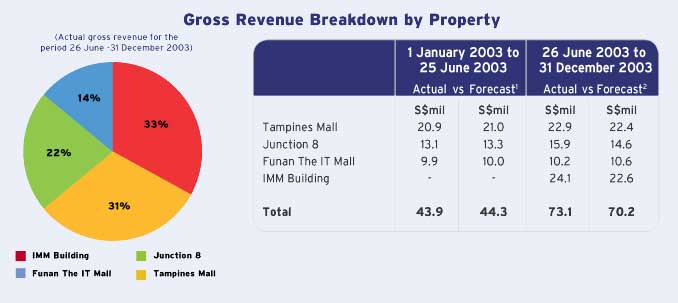|
The CMT portfolio comprises Tampines
Mall, Junction 8, Funan The IT Mall and IMM Building totalling
1,706,995 square feet of NLA as at 31 December 2003. The portfolios
income stream is well supported by a large and diverse pool
of more than 900 committed leases with gross rental income
of S$107 million for the year ended 31 December 2003.

The locality of the four malls capitalises
on the traffic flow from the MRT stations which are located
either beside or near to the malls. With IMM in the west of
Singapore, Junction 8 in the north, Tampines Mall in the east
and Funan in the city area, CMT is poised to capture most
regional segments of the Singapore population.
|
The 3-year lease terms for retail
tenants, which is consistent with the general practice
in the Singapore property market, exposes CMT to certain
risks as a result of the significant rates of lease
expiries each year. With a pro-active leasing strategy,
these risks can be mitigated. As at 31 January 2004,
26 percent of leases due for renewal in 2004 have been
renewed. This places CMT in a good position to meet
expectations. Moreover, with prime suburban locations
in high demand and limited competition, CMT is well
positioned to capitalise on these factors for its future
growth. |
|
 |
Gross Rental Income is also well distributed
amongst the different tenants, with Cold Storage (Singapore)(1983)
Pte Ltd making the highest contribution of 4.2 percent. Additionally,
the top 10 tenants which occupy 27.5 percent of the total
NLA, contribute 21.6 percent of Gross Rental Income to the
portfolio.
 |
- For the month of December 2003.
- As at 31 December 2003.
|
With the addition of IMM, income contribution
from the malls is generally well balanced, with Tampines Mall
contributing the largest share of 37 percent of the portfolio
NPI, for the period 26 June to 31 December 2003. The even
distribution of income sources produces a more stable and
secured portfolio.
All properties have contributed positively
to the bottom line. With the exception of Funan, all properties
have exceeded forecasts relating to NPI and gross revenue.
For Funan, the slight decline was due to an increase in vacancy
voids arising from asset enhancements and an increase in fitting
out expenses, in a deliberate attempt on the Managers part
to ensure Funan is positioned for long term sustainability.

- Based on the forecast, together with
the accompanying assumptions, in the CMT circular dated
11 June 2003 for all the properties (excluding IMM Building)
for 2003 excluding the forecast for the period from June
to December 2003 but including the pro-rated forecast for
the first 25 days of the June to December 2003 period.
- Based on the forecast, together with
the accompanying assumptions, in the CMT circular dated
11 June 2003 for all the properties for the period from
June to December 2003 pro-rated for the period from 26 June
to 31 December 2003.

- Based on the forecast, together with
the accompanying assumptions, in the CMT circular dated
11 June 2003 for all the properties (excluding IMM Building)
for 2003 excluding the forecast for the period from June
to December 2003 but including the pro-rated forecast for
the first 25 days of the June to December 2003 period.
- Based on the forecast, together with
the accompanying assumptions, in the CMT circular dated
11 June 2003 for all the properties for the period from
June to December 2003 pro-rated for the period from 26 June
to 31 December 2003.
A good spread in the trade mix ensures that
CMT is not overly reliant on any one particular segment of
the retail sector. At present, food & beverage outlets
are the top contributors to the total gross rental income,
contributing 20 percent to the total gross rental income and
accounting for 13 percent of the total NLA. This ensures that
risks are well spread across all retail segments.

|
